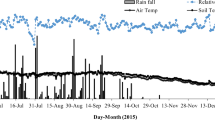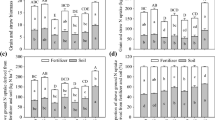Summary
Using 15N, the fate of N applied to wetland rice either as Azolla or urea was studied in a field at the International Rice Research Institute (IRRI). In bigger plots nearby, yield response and N uptake were also determined with unlabelled N sources. Azolla microphylla was labelled by repeated application of labelled ammonium sulfate. Labelled and unlabelled N were used alternately in applications of Azolla or urea 0 and 42 days after transplanting, in order to determine the effect of the time of application on the availability of Azolla N. The quantities of Azolla N incorporated were 23% more than those of urea N (30 kg N ha−1) in the isotope plots or 7% less in the yield response plots. Grain yield and total N uptake by the rice plants in the yield-response plots were higher in the urea-treated plots than in the Azolla-treated plots, but the physiological effect of Azolla N (grain yield response/increase in N uptake) was higher than that of rea. The labelled N balance was studied after the first and second crops of rice. Losses of labelled N after the first crop were higher from urea (30%–32%) than from Azolla (0%–11 %). Losses in N applied as a side dressing 42 days after transplanting were less than those of N applied basally. No further losses of 15N occurred after the first crop. The recovery of Azolla 15N in the first crop of rice was 39% from the basal application and 63% from the side dressing. The recovery of urea 15N was 27% from the basal application and 48% from the side dressing. Recoveries of residual N from both Azolla and urea during the second rice crop were similar. Laboratory incubation of the Azolla used and the changes in labelled exchangeable N in the soil showed that at least 65% of Azolla N (4.7% N content) was mineralized within 10 days.
Similar content being viewed by others
References
Bouldin D (1986) The chemistry and biology of flooded soils in relation to the nitrogen economy in rice fields. In: De Datta SK, Patrick WH (eds) Nitrogen economy of flooded rice soils. Nijhoff, The Hague, pp 1–4
Cao ZH, De Datta SK, Fillery IRP (1984a) Effect of placement methods on floodwater properties and recovery of applied nitrogen (15N labelled urea) in wetland rice. Soil Sci Soc Am J 48:196–203
Cao ZH, De Datta SK, Fillery IRP (1984b) Nitrogen-15 balance and residual effects of urea-N in wetland rice fields as affected by deep placement techniques. Soil Sci Soc Am J 48:203–208
Craswell ET, Godwin DC (1984) The efficiency of nitrogen fertilizers applied to cereals in different climates. In: Tinker PB, Lanchli A (eds) Advances in plant nutrition. Prager Scientific, New York, pp 1–55
Eskew DL (1987) Use of 15N in N2-fixation and N cycling studies of Azolla. In: Azolla utilization. Int Rice Res Inst (Los Baños), pp 233–239
Ito O, Watanabe I (1985) Availability to rice plant of nitrogen fixed by Azolla. Soil Sci Plant Nutr 31:91–104
Jenkinson DS, Fox RH, Rayner J (1986) Interactions between fertilizer nitrogen and soil nitrogen: The so-called “priming effect”. J Soil Sci 36:424–444
Kumarasinghe KS, Zapata F, Kovacs G, Eskew DL, Danso SKA (1986) Evaluation of the availability of Azolla N and urea-N using 15N. Plant and Soil 90:293–299
Mian MH, Stewart WDP (1985a) Fate of nitrogen applied as Azolla and blue green algae (Cyanobacteria) in waterlogged rice soils — 15N tracer study. Plant and Soil 83:363–370
Mian MH, Stewart WDP (1985b) A 15N tracer to compare nitrogen supply by Azolla and ammonium sulphate to IR8 rice plants grown under flooded conditions. Plant and Soil 83:371–379
Rains DW, Talley SN (1979) Use of Azolla in North America. In: Nitrogen and rice. Int Rice Res Inst (Los Baños), pp 419–433
Reynaud PA (1985) Growth and nitrogen fixation of Azolla pinnata var africana: Environmental conditions and field plot inoculation assays. In: The role of isotopes in studies of nitrogen fixation and nitrogen cycling by blue-green algae and the Azolla-Anabaena Azollae association. IAEA Technical Document 325, International Atomic Energy Agency, Vienna, pp 39–51
Shiga H, Ventura W (1976) Nitrogen supplying ability of paddy soils under field conditions in the Philippines. Soil Sci Plant Nutr 22:387–399
Tirol AC, Roger PA, Watanabe I (1982) Fate of nitrogen from bluegreen algae in a flooded rice soil. Soil Sci Plant Nutr 28:559–569
Van Hove C, De Waha Baillonville T, Diara HF, Godard P, Mai Kodami Y, Sanginga N (1987) Azolla collection and selection. In: Azolla utilization. Int Rice Res Inst (Los Baños), pp 77–87
Ventura W, Watanabe I (1978) Dry season soil conditions and soil nitrogen availability to wet season wetland rice. Soil Sci Plant Nutr 24:535–545
Vlek PLG, Brynes BH (1986) The efficacy and loss of fertilizer N in lowland rice. Fert Res 9:131–147
Watanabe I (1987) Summary report of the Azolla program of the International Network in Soil Fertility and Fertilizer Evaluation for Rice. In: Azolla utilization. Proceedings of the workshop on Azolla use. Int Rice Res Inst (Los Baños), pp 197–205
Watanabe I, Espinas CR, Berja NS, Alimagno BV (1977) Utilization of Azolla-Anabaena complex as a nitrogen fertilizer for lowland rice. Int Rice Res Pap Ser 11 (Los Baños)
Westcott MP, Mikkelsen DS (1985) Comparative effects of an organic and inorganic nitrogen source in flooded soils. Soil Sci Soc Am J 49:1470–1475
Yoneyama T, Kumazawa K (1974) A simple determination of 15N abundance in plant powder sample. J Sci Soil Manure (Japan) 45:480–482 (in Japanese)
Author information
Authors and Affiliations
Rights and permissions
About this article
Cite this article
Watanabe, I., Ventura, W., Mascariña, G. et al. Fate of Azolla spp. and urea nitrogen applied to wetland rice (Oryza sativa L.). Biol Fert Soils 8, 102–110 (1989). https://doi.org/10.1007/BF00257752
Received:
Issue Date:
DOI: https://doi.org/10.1007/BF00257752




